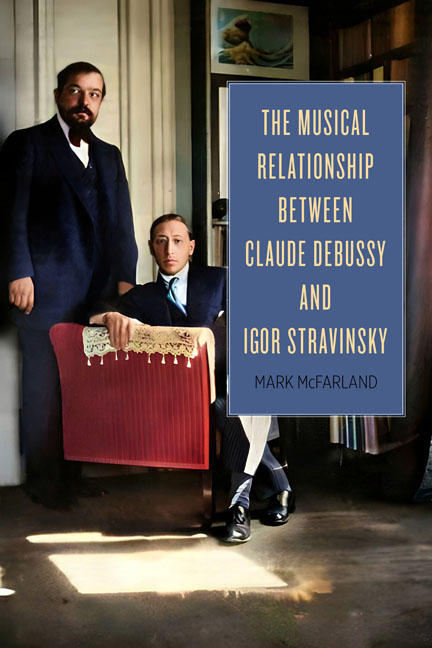Book contents
- Frontmatter
- Dedication
- Contents
- Acknowledgments
- Introduction
- 1 A Mutual Influence
- 2 Cinematic Montage and Stratified Form
- 3 Stratified Form in Debussy’s Works: 1909–1913
- 4 Debussy and the Chromatic Set
- 5 Stratified Form in Jeux
- 6 Stravinsky’s Waning Influence: 1914–1917
- Conclusion
- Glossary
- Bibliography
- Index
Conclusion
Published online by Cambridge University Press: 10 May 2024
- Frontmatter
- Dedication
- Contents
- Acknowledgments
- Introduction
- 1 A Mutual Influence
- 2 Cinematic Montage and Stratified Form
- 3 Stratified Form in Debussy’s Works: 1909–1913
- 4 Debussy and the Chromatic Set
- 5 Stratified Form in Jeux
- 6 Stravinsky’s Waning Influence: 1914–1917
- Conclusion
- Glossary
- Bibliography
- Index
Summary
This study has been one of Debussy's changing styles from his first book of preludes from 1907–10 to the composition of the second book of preludes along with Jeux in 1912–13. In chapter 6 we explored the last change in style, as the most advanced style Debussy used gradually evaporated. The catalyst behind these changes was seen to be Debussy's relationship with Stravinsky. While The Firebird in 1910 did not immediately win over Debussy, Petrushka in 1911 did. From this point Debussy began his octatonic exploration, having heard what magnificent use could be made of it in Stravinsky's ballets.
In 1910, completely independent of his relationship with Stravinsky, Debussy composed “Ce qu’a vu le vent d’ouest,” which contained a consistent opposition between diatonic (asymmetrical) scales and chromatic (symmetrical) scales. The form of this work was created from the intertwining of the various lines of the composition, each line devoted to a distinct scale. This was the first of Debussy's works in stratified form, and it was with the invention of this formal organization that the French composer was able to influence the young Russian, for Stravinsky used sections of stratified form in Petrushka and The Rite, and eventually made the leap from stage to concert work with the Symphonies of Wind Instruments in 1920 and other works throughout his long career.
Debussy's stratified works share many of the following characteristics: a continuous opposition between diatonic and chromatic scales, an introduction that hints at scales without overtly stating them, the body of a work made up of strands of the various lines used that determine the form, one scale per line, and synthesis between the various lines at the end of the work and often briefly throughout. The work that best exemplifies this is “Ondine,” which exhibits such craft in its construction that it is hypothesized to be among the last of the preludes to be composed. “Ondine” exhibited discontinuity with each juxtaposition of lines, but this is actually rare in Debussy's stratified works. Most are continuous, with the job of separating the various lines falling to the distinct harmony assigned to each one. Other preludes written with a stratified form include “Les tierces alternées,” “Feuilles mortes,” “Les fées sont d’exquises danseuses,” “‘Général Lavine’—eccentric,” “La terrace des audiences du clair de lune,” “Brouillards,” and “Feux d’artifice.”
- Type
- Chapter
- Information
- Publisher: Boydell & BrewerPrint publication year: 2024



